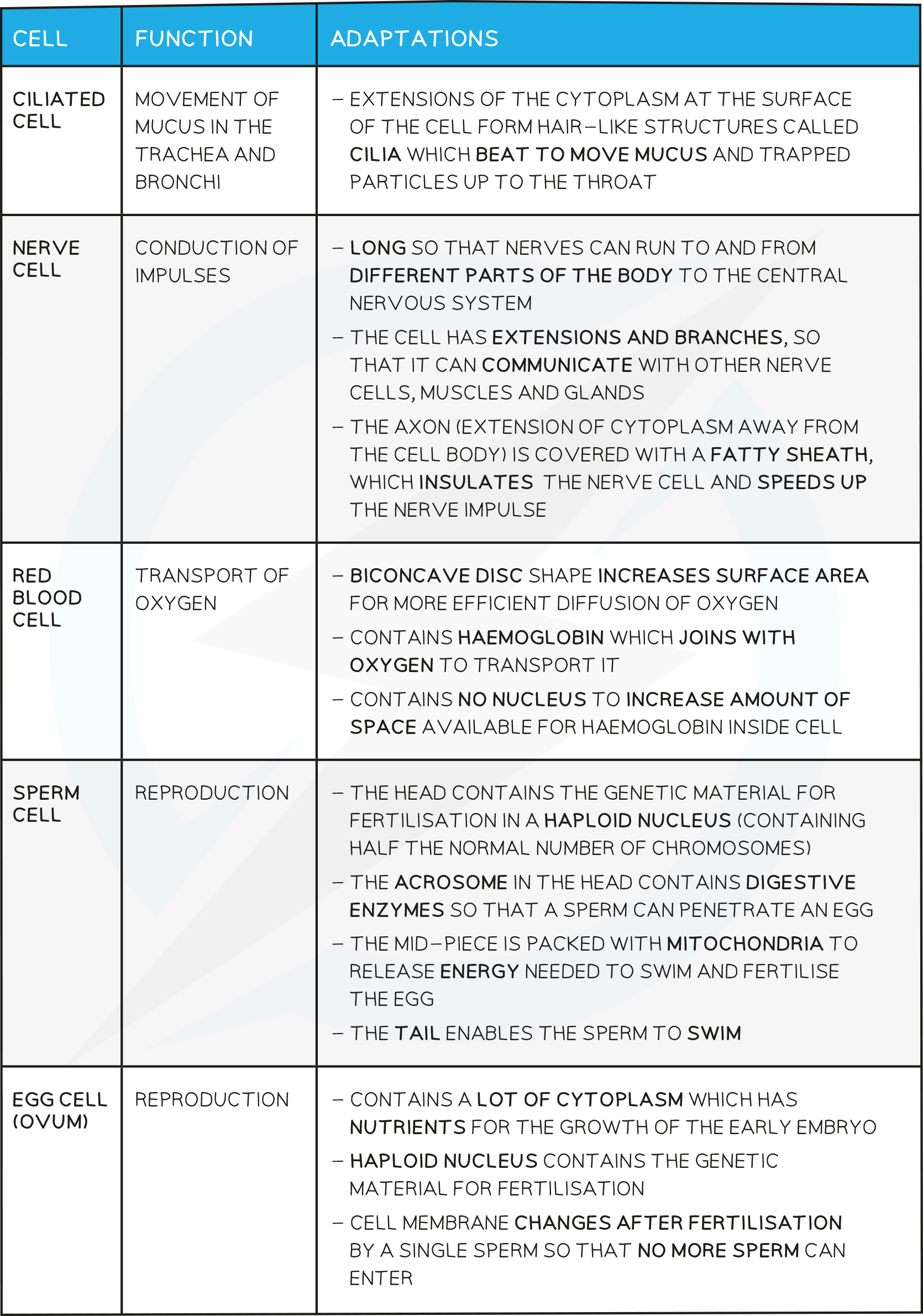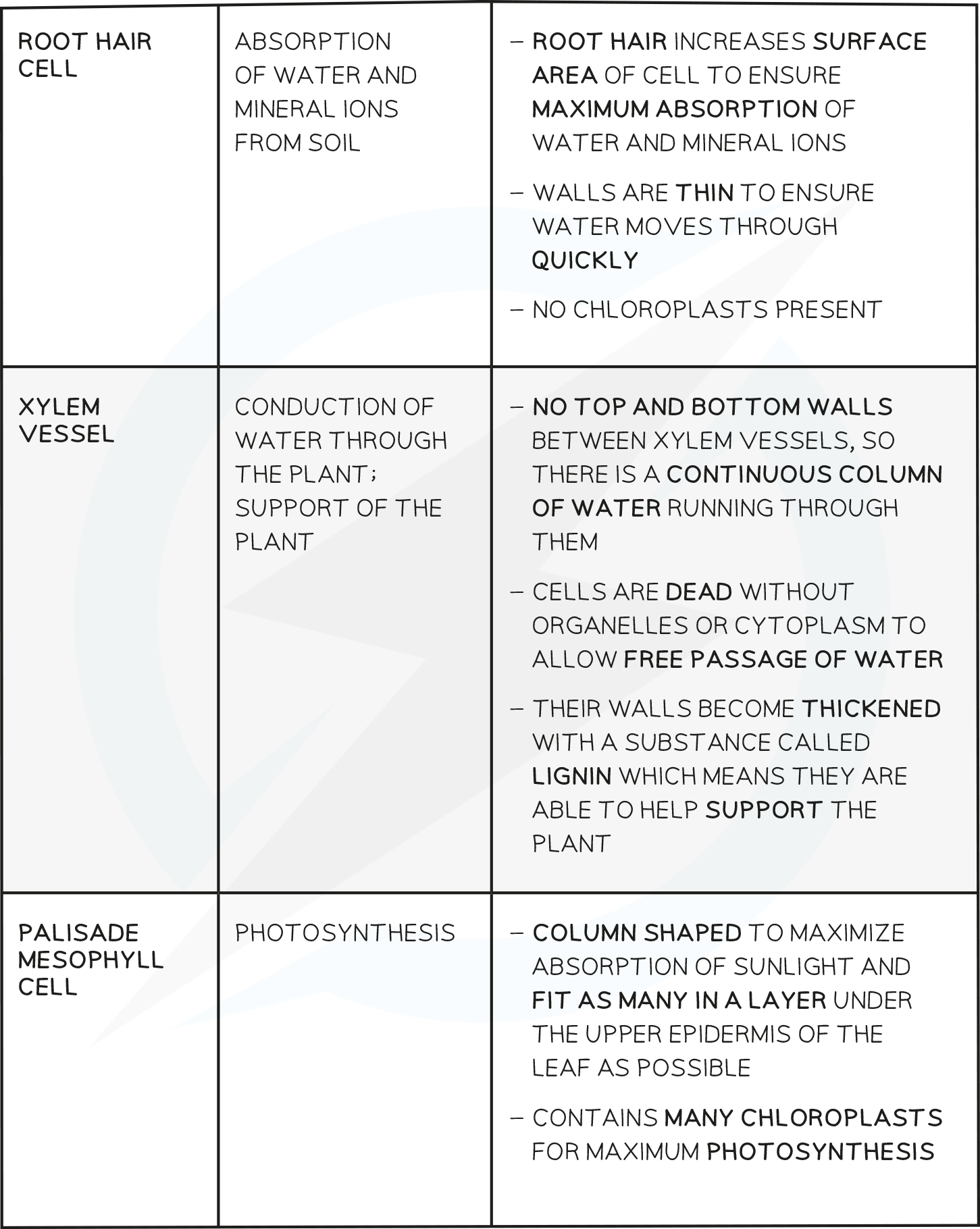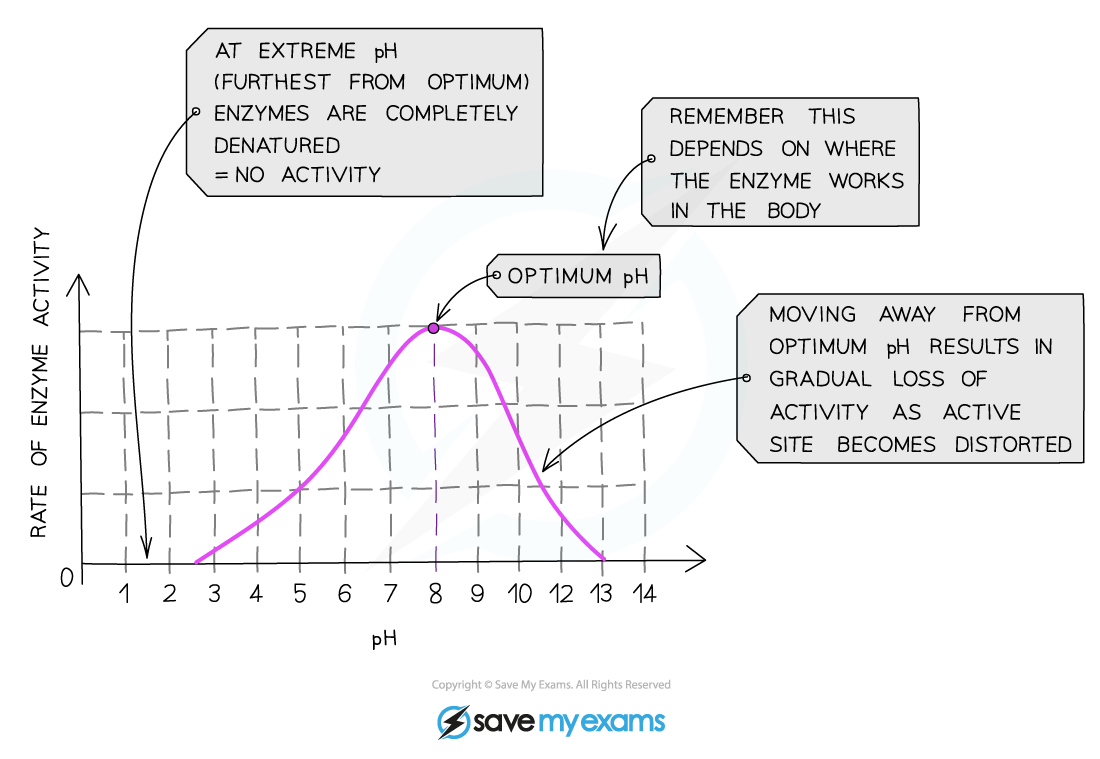Structure & Function in Living Organisms
Levels of organization
Organelle → Cell → Tissues → Organ → Organ system → Organism
Cell structure
Animal V.S. Plant cell

Structure | Function |
Nucleus |
|
Cytoplasm |
|
Cell membrane |
|
Mitochondria |
|
Ribosome |
|
Cell wall |
|
Chloroplast |
|
Permanent vacuole |
|
Importance of Cell Differentiation
Cell differentiation is an important process by which a cell changes to become specialised
Specialised cells are those that have developed certain characteristics that allow them to perform particular functions. These differences are controlled by genes in the nucleus

As a multicellular organism develops, its cells differentiate to form specialised cells
In an animal, most cells differentiate at an early stage of development
As a result, animal cells lose their ability to differentiate early in the life of the organism
Specific cells in various locations throughout the body of an animal retain the ability to differentiate throughout the life of the animal
These undifferentiated cells are called adult stem cells and they are mainly involved in replacing and repairing cells (such as blood or skin cells)
Plants differ from animals in that many types of plant cells retain the ability to fully differentiate throughout the life of a plant, not just in the early stages of development
Example of specialized animal cells:

Example of specialized plant cells:

Biological molecule
Carbohydrates
Carbohydrates contain the elements carbon, hydrogen and oxygen
Carbohydrates can be small, simple sugars or more complex larger molecules
A monosaccharide is a simple sugar e.g. glucose (C6H12O6) or fructose
A disaccharide is made when two monosaccharides join together, e.g. maltose is formed from two glucose molecules
A large polysaccharide is formed when lots of monosaccharides join together
Starch, glycogen or cellulose are all formed when lots of simple glucose molecules join together
Polysaccharides are insoluble and therefore useful as storage molecules
Lipids
Most lipids in the body are made up of triglycerides
Their basic unit is one glycerol molecule chemically bonded to three fatty acid chains
The fatty acids vary in size and structure
Lipids are divided into fats (solids at room temperature) and oils (liquids at room temperature)
Proteins
Proteins are formed from long chains of amino acids
When amino acids are joined together a protein is formed
Amino acids can be arranged in any order, resulting in hundreds of thousands of different proteins
Different proteins have different amino acid sequences resulting in them having different shapes; the shape of a protein determines its function
Examples of proteins include enzymes, haemoglobin, ligaments and keratin
Food tests
Benedict
for reducing sugars
Heat in a boiling water bath for 5 minutes
Take the test tube out of the water bath and observe the color
Iodine
for starch
Add drops of iodine solution to the food sample
Biuret
for proteins
Add drops of Biuret solution to the food sample
Ethanol
Mix the food sample with ethanol and shake
Allow time for the sample to dissolve in the ethanol
Strain the ethanol solution into another test tube
Add the ethanol solution to an equal volume of cold distilled water
A positive test will show a cloudy emulsion forming

Enzyme
Enzymes are proteins that act as biological catalysts to speed up the rate of a chemical reaction without being changed or used up in the reaction
Enzymes are necessary to all living organisms as they maintain reaction speeds of all metabolic reactions at a rate that can sustain life
For example, if we did not produce digestive enzymes, it would take around 2 - 3 weeks to digest one meal; with enzymes, it takes around 4 hours
Often the products of one reaction are the reactants for another (and so on)
How enzymes work:
Step One: Enzymes and substrates randomly move about in solution
Step Two: When an enzyme and its complementary substrate randomly collide an enzyme-substrate complex forms, and the reaction occurs
Step Three: A product (or products) forms from the substrate(s) which are then released from the active site. The enzyme is unchanged and will go on to catalyse further reactions


The optimum pH for most enzymes is 7
Some enzymes that are produced in acidic conditions, such as the stomach, have a lower optimum pH (pH 2)
Some that are produced in alkaline conditions, such as the duodenum, have a higher optimum pH (pH 8 or 9)
Movement of substances
Diffusion
Definition: The movement of molecules from a region of higher concentration to a region of lower concentration
Molecules move down a concentration gradient
Passive process (doesn’t require energy)
Note that the movement of molecules is random
Molecules move into or out of living cells by diffusion when they cross the cell membrane
Diffusion allows living organisms to, e.g.:
gain nutrients in the digestive system
gain oxygen in the lungs
remove waste products in the lungs and kidneys

Osmosis
Definition: The movement of water molecules from a region of higher water concentration (a dilute solution) to a region of lower water concentration (a concentrated solution), through a partially permeable membrane
Osmosis is the diffusion of water
Passive process (doesn’t require energy)
The water is moving down its concentration gradient
Partially permeable membranes prevent the movement of larger molecules

Active transport
Definition: The movement of particles across a cell membrane from a region of lower concentration to a region of higher concentration
Energy is needed for active transport because particles are being moved against a concentration gradient
Active transport across the cell membrane involves protein carrier molecules that are embedded in the cell membrane
Examples of active transport in cells include:
absorption of the products of digestion into the bloodstream from the lumen of the small intestine
absorption of mineral ions from the soil into the root hair cells of plants
Factors that affect the movement of substances
Surface area to volume ratio
bigger the surface area, the fastest the movement will happen
Diffusion distance
smaller distance → faster movement of particles
Temperature
The higher the temperature, the faster molecules move as they have more energy
Concentration gradient
The greater the difference in concentration on either side of the membrane, the faster movement across it will occur
Nutrition
Photosynthesis
Photosynthesis can be defined as the process by which plants manufacture carbohydrates from raw materials using energy from light
Plants are
Autotrophs – they can make complex molecules (glucose) from simple molecules (carbon dioxide and water)


Factors that affect the rate of photosynthesis:
Temperature

Light intensity

Carbon dioxide concentration

Chlorophyll
The number of chloroplasts (as they contain the pigment chlorophyll which absorbs light energy for photosynthesis) will affect the rate of photosynthesis
Leaf structure
Structure | Description |
Wax cuticle | Protective layer on top of the leaf, prevents water from evaporating |
Upper epidermis | Thin and transparent to allow light to enter palisade mesophyll layer underneath it |
Palisade mesophyll | Column-shaped cells tightly packed with chloroplasts to absorb more light, maximising photosynthesis |
Spongy mesophyll | Contains internal air spaces that increase the surface area to volume ratio for the diffusion of gases (mainly carbon dioxide) |
Lower epidermis | Contains guard cells and stomata |
Guard cell | Absorbs and loses water to open and close the stomata to allow carbon dioxide to diffuse in, oxygen to diffuse out |
Stomata | Where gas exchange takes place: opens during the day, closes during the night. Evaporation of water also takes place from here. In most plants, found in much greater concentration on the underside of the leaf to reduce water loss |
Vascular bundle | Contains xylem and phloem to transport substances to and from the leaf |
Xylem | Transports water into the leaf for mesophyll cells to use in photosynthesis and for transpiration from stomata |
Phloem | Transports sucrose and amino acids around the plant |
Mineral ions!!!
Balanced diet
The necessary key food groups are:
Carbohydrates
Proteins
Lipids
Dietary fiber
Vitamins
Minerals (mineral ions)
Water
Having an unbalanced diet can lead to malnutrition
Malnutrition can cause a variety of different health problems in humans
There are seven main food groups. These are:
Carbohydrates
Function: source of energy
Sources: bread, cereals, pasta, rice, potatoes
Protein
Function: growth and repair
Sources: meat, fish, eggs, pulses, nuts
Lipid (fats and oils)
Function: insulation and energy storage
Sources: butter, oil, nuts
Dietary fibre
Function: provides bulk (roughage) for the intestine to push food through it
Sources: vegetables, whole grains
Vitamins and minerals
Function: needed in small quantities to maintain health
Sources: fruits and vegetables, meats, dairy products
Water
Function: needed for chemical reactions to take place in the body
Sources: water, juice, milk, fruits and vegetables
Examples of vitamins and minerals include:
Calcium is needed for strong teeth and bones and is involved in the clotting of blood
A deficiency can lead to osteoporosis later in life
It is found in milk, cheese, and eggs
Vitamin D helps the body to absorb calcium and is required for strong bones and teeth
It can be found in oily fish and dairy products, and is also made naturally by the body in sunlight
Vitamin C forms an essential part of collagen protein, which makes up the skin, hair, gums, and bones
A deficiency can cause scurvy. It is found in citrus fruits and some green vegetables
Vitamin A is needed to make the pigment in the retina for vision
It can be found in meat, liver, dairy, leafy green vegetables like spinach, and eggs
Iron is needed to make haemoglobin, the pigment in red blood cells that helps to carry oxygen
It can be found in red meat, liver, leafy green vegetables, and spinach
An individual will still require the same key food groups, but in different quantities depending on a number of factors such as age, height, sex, activity levels, pregnancy and breastfeeding
Human Alimentary Canal

The Stages of Food Breakdown
Food taken into the body goes through six different stages during its passage through the alimentary canal (the gut):
Ingestion - the taking in of substances, e.g. food and drink, into the body through the mouth
Mechanical digestion - the breakdown of food into smaller pieces without chemical change to the food molecules
Chemical digestion - the breakdown of large, insoluble molecules into small, soluble molecules
Absorption - the movement of small food molecules and ions through the wall of the intestine into the blood
Assimilation - the movement of digested food molecules into the cells of the body where they are used, becoming part of the cells
Egestion - the passing out of food that has not been digested or absorbed (as faeces) through the anus
Structure | Function |
Mouth / salivary glands | Mechanical digestion: teeth chew food to break it into smaller pieces and increase its surface area to volume ratio. Chemical digestion: amylase enzymes in saliva start digesting starch into maltose. The food is shaped into a bolus (ball) by the tongue and lubricated in saliva so it can be swallowed easily. |
Oesophagus | The tube that connects the mouth to the stomach where the food bolus goes after being swallowed. Wave-like contractions will take place to push the food bolus down without relying on gravity. |
Stomach | Food is mechanically digested by churning actions while protease enzymes start to chemically digest proteins. Hydrochloric acid is present to kill bacteria in food and provide the optimum pH for protease enzymes to work. |
Small intestine | The first section is called the duodenum and is where the food coming out of the stomach finishes being digested by enzymes produced here and also secreted from the pancreas. pH of the small intestine is slightly alkaline - around pH 8-9. The second section is called the ileum and is where the absorption of digested food molecules takes place. The ileum is long and lined with villi to increase the surface area over which absorption can take place. |
Large intestine | Water is absorbed from the remaining material in the colon to produce faeces. Faeces is stored in the rectum and removed through the anus. |
Pancreas | Produces all three types of digestive enzymes: amylase, protease and lipase. Secretes enzymes in an alkaline fluid into the duodenum for digestion to raise the pH of fluid coming out of the stomach. Produces bile to emulsify fats (break large droplets into smaller droplets), an example of mechanical digestion. |
Liver | Amino acids that are not used to make proteins are broken down here (deamination), producing urea. Stores bile to release into the duodenum as required. |
Gall bladder | Stores bile to release into the duodenum as required. |
Peristalsis
Peristalsis is a mechanism that helps moves food along the alimentary canal
Firstly, muscles in the walls of the oesophagus create waves of contractions which force the bolus along
Once the bolus has reached the stomach, it is churned into a less solid form, called chyme, which continues on to the small intestine
Peristalsis is controlled by circular and longitudinal muscles
Circular muscles contract to reduce the diameter of the lumen of the oesophagus or small intestine
Longitudinal muscles contract to reduce the length of that section the oesophagus or the small intestine
Mucus is produced to continually lubricate the food mass and reduce friction
Dietary fiber provides the roughage required for the muscles to push against during peristalsis

Role of Digestive Enzymes
Food is partially digested mechanically (by chewing, churning and emulsification) in order to break large pieces of food into smaller pieces of food which increases the surface area for enzymes to work on
Digestion mainly takes place chemically, where bonds holding the large molecules together are broken to make smaller and smaller molecules
There are three main types of digestive enzymes – carbohydrases, proteases and lipases
Carbohydrates

Proteins

Lipids

Bile
Bile is an alkaline substance produced by cells in the liver
Before being released into the small intestine, bile is stored in the gall bladder
Bile contains bile salts. It is these molecules which emulsify the lipids, however you can use both terms interchangeably.
Bile has two main roles:
Neutralising the hydrochloric acid from the stomach
The alkaline properties of bile allow for this to occur
This neutralisation is essential as enzymes in the small intestine have a higher (more alkaline) optimum pH than those in the stomach
Breaking apart large drops of lipids (fats) into smaller ones (and so increasing their surface area)
This is known as emulsification
The more alkaline conditions and larger surface area allows lipase to chemically break down the lipid molecules into glycerol and fatty acids at a faster rate